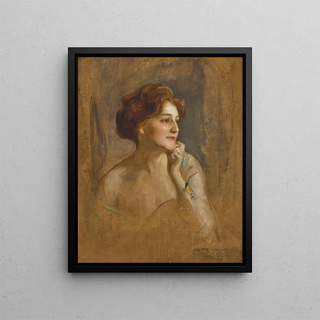Art print | Countess Robert de Pourtalès née Marie Elisabeth van Rijck - Philip Alexius de László


View from behind

Frame (optional)
The art print of Countess Robert de Pourtalès née Marie Elisabeth van Rijck - Philip Alexius de László immerses us in the fascinating world of early 20th-century European high society. This iconic piece, created by a master of portraiture, evokes not only the beauty and elegance of its subject but also the refined atmosphere of an era where art and fashion intertwined intimately. The Countess, an emblematic figure of her time, is depicted with a grace and dignity that transcend mere conventions of portraiture. Light plays across her features, revealing a psychological depth that invites the viewer to ponder her personal history and societal role.
Style and uniqueness of the work
Philip Alexius de László's style is characterized by an exceptional mastery of nuances and textures, which is evident in this art print. The treatment of drapery and fabrics, as well as the delicacy of details, demonstrate meticulous attention to every element. The color palette chosen by the artist enhances the elegance of the portrait, with soft tones that highlight the natural beauty of the Countess. László manages to capture not only the physical appearance of his model but also an essence, an atmosphere that brings the art print to life. Each brushstroke seems charged with emotion, creating a dialogue between the viewer and the subject, an exchange where intimacy blends with the inherent distance of artistic representation.
The artist and his influence
Philip Alexius de László, of Hungarian origin, established himself as one of the most sought-after portraitists of his time. His career, marked by encounters with prominent figures in culture and politics, allowed him to develop a distinctive style that combines realism and romanticism. Influenced by the great masters of the past, he reinterpreted the codes of portraiture to adapt them to his era. László not only left an indelible mark on the art world but also contributed to shaping the image of European nobility.

Matte finish

View from behind

Frame (optional)
The art print of Countess Robert de Pourtalès née Marie Elisabeth van Rijck - Philip Alexius de László immerses us in the fascinating world of early 20th-century European high society. This iconic piece, created by a master of portraiture, evokes not only the beauty and elegance of its subject but also the refined atmosphere of an era where art and fashion intertwined intimately. The Countess, an emblematic figure of her time, is depicted with a grace and dignity that transcend mere conventions of portraiture. Light plays across her features, revealing a psychological depth that invites the viewer to ponder her personal history and societal role.
Style and uniqueness of the work
Philip Alexius de László's style is characterized by an exceptional mastery of nuances and textures, which is evident in this art print. The treatment of drapery and fabrics, as well as the delicacy of details, demonstrate meticulous attention to every element. The color palette chosen by the artist enhances the elegance of the portrait, with soft tones that highlight the natural beauty of the Countess. László manages to capture not only the physical appearance of his model but also an essence, an atmosphere that brings the art print to life. Each brushstroke seems charged with emotion, creating a dialogue between the viewer and the subject, an exchange where intimacy blends with the inherent distance of artistic representation.
The artist and his influence
Philip Alexius de László, of Hungarian origin, established himself as one of the most sought-after portraitists of his time. His career, marked by encounters with prominent figures in culture and politics, allowed him to develop a distinctive style that combines realism and romanticism. Influenced by the great masters of the past, he reinterpreted the codes of portraiture to adapt them to his era. László not only left an indelible mark on the art world but also contributed to shaping the image of European nobility.






